Analysis and Optimization of Light Absorption and Scattering Properties of Metal Nanocages
Abstract
:1. Introduction
2. Model and Method
2.1. Simulation Model
2.2. Fundamental Theory
2.3. Numerical Verification of FEM
3. Results and Discussion
3.1. Effect of Materials on Light Absorption and Scattering
3.2. Effect of Size on Light Absorption and Scattering
3.2.1. Effect of Edge Length
3.2.2. Effect of Aspect Ratio
3.3. Effect of Surrounding Medium on Light Absorption and Scattering
3.4. Effect of Incident Light Orientation on Light Absorption and Scattering
3.5. Optimization of Light Absorption and Scattering
3.5.1. Optimum Size Parameters for PTT
3.5.2. Optimum Size Parameters for Bio-Imaging
4. Conclusions
Author Contributions
Funding
Data Availability Statement
Acknowledgments
Conflicts of Interest
References
- Hussein, E.; Zagho, M.; Nasrallah, G.; Elzatahry, A. Recent Advances in Functional Nanostructures as Cancer Photothermal Therapy. IJN 2018, 13, 2897–2906. [Google Scholar] [CrossRef] [PubMed]
- Kumari, S.; Sharma, N.; Sahi, S.V. Advances in Cancer Therapeutics: Conventional Thermal Therapy to Nanotechnology-Based Photothermal Therapy. Pharmaceutics 2021, 13, 1174. [Google Scholar] [CrossRef] [PubMed]
- Li, X.; Lovell, J.F.; Yoon, J.; Chen, X. Clinical Development and Potential of Photothermal and Photodynamic Therapies for Cancer. Nat. Rev. Clin. Oncol. 2020, 17, 657–674. [Google Scholar] [CrossRef] [PubMed]
- Liu, S.; Pan, X.; Liu, H. Two-Dimensional Nanomaterials for Photothermal Therapy. Angew. Chem. 2020, 132, 5943–5953. [Google Scholar] [CrossRef]
- Vines, J.B.; Yoon, J.-H.; Ryu, N.-E.; Lim, D.-J.; Park, H. Gold Nanoparticles for Photothermal Cancer Therapy. Front. Chem. 2019, 7, 167. [Google Scholar] [CrossRef]
- Gotwals, P.; Cameron, S.; Cipolletta, D.; Cremasco, V.; Crystal, A.; Hewes, B.; Mueller, B.; Quaratino, S.; Sabatos-Peyton, C.; Petruzzelli, L.; et al. Prospects for Combining Targeted and Conventional Cancer Therapy with Immunotherapy. Nat. Rev. Cancer 2017, 17, 286–301. [Google Scholar] [CrossRef]
- Wumaier, D.; Tuersun, P.; Li, S.; Li, Y.; Wang, M.; Xu, D. Light Absorption Analysis and Optimization of Ag@TiO2 Core-Shell Nanospheroid and Nanorod. Nanomaterials 2024, 14, 325. [Google Scholar] [CrossRef]
- Duan, S.; Hu, Y.; Zhao, Y.; Tang, K.; Zhang, Z.; Liu, Z.; Wang, Y.; Guo, H.; Miao, Y.; Du, H.; et al. Nanomaterials for Photothermal Cancer Therapy. RSC Adv. 2023, 13, 14443–14460. [Google Scholar] [CrossRef]
- Lv, W.; Ye, J.; Wang, Q.; Li, C.; Wang, J.; Zhang, Z.; Niu, N.; Liu, Z.; Xu, J.; Fu, Y. Tumor-Responsive Upconversion Nanoparticles with Tunable Degradability and Ultrabright Emission for Optical Bioimaging. ACS Appl. Nano Mater. 2022, 5, 9367–9378. [Google Scholar] [CrossRef]
- Zhang, W.; Chen, S.; Sun, P.; Ye, S.; Fan, Q.; Song, J.; Zeng, P.; Qu, J.; Wong, W.-Y. NIR-II J-Aggregated Pt(II)-Porphyrin-Based Phosphorescent Probe for Tumor-Hypoxia Imaging. Adv. Healthc. Mater. 2022, 11, 2200467. [Google Scholar] [CrossRef]
- Moghimi, S.M. Nanoparticle Patterning for Biomedicine. Bioimpacts 2016, 6, 183–185. [Google Scholar] [CrossRef] [PubMed]
- Jiang, Z.; Zhang, M.; Li, P.; Wang, Y.; Fu, Q. Nanomaterial-Based CT Contrast Agents and Their Applications in Image-Guided Therapy. Theranostics 2023, 13, 483–509. [Google Scholar] [CrossRef] [PubMed]
- Setia, A.; Challa, R.R.; Vallamkonda, B.; Satti, P.; Mehata, K.; Priya, V.; Kumar, S.; Muthu, M.S. Nanomedicine and Nanotheranostics: Special Focus on Imaging of Anticancer Drugs Induced Cardiac Toxicity. Nanotheranostics 2024, 8, 473. [Google Scholar] [CrossRef]
- Ruan, Q.; Shao, L.; Shu, Y.; Wang, J.; Wu, H. Growth of Monodisperse Gold Nanospheres with Diameters from 20 Nm to 220 Nm and Their Core/Satellite Nanostructures. Adv. Opt. Mater. 2014, 2, 65–73. [Google Scholar] [CrossRef]
- Zhang, Q.; Li, W.; Moran, C.; Zeng, J.; Chen, J.; Wen, L.-P.; Younan, X. Seed-Mediated Synthesis of Ag Nanocubes with Controllable Edge Lengths in the Range of 30–200 Nm and Comparison of Their Optical Properties. J. Am. Chem. Soc. 2010, 132, 11372. [Google Scholar] [CrossRef]
- Rycenga, M.; Cobley, C.M.; Zeng, J.; Li, W.; Moran, C.H.; Zhang, Q.; Qin, D.; Xia, Y. Controlling the Synthesis and Assembly of Silver Nanostructures for Plasmonic Applications. Chem. Rev. 2011, 111, 3669. [Google Scholar] [CrossRef] [PubMed]
- Dreaden, E.C.; Alkilany, A.M.; Huang, X.; Murphy, C.J.; El-Sayed, M.A. The Golden Age: Gold Nanoparticles for Biomedicine. Chem. Soc. Rev. 2012, 41, 2740. [Google Scholar] [CrossRef]
- Zhang, Z.; Zhang, C.; Zheng, H.; Xu, H. Plasmon-Driven Catalysis on Molecules and Nanomaterials. Acc. Chem. Res. 2019, 52, 2506–2515. [Google Scholar] [CrossRef]
- Liu, Y.; Xu, M.; Chen, Q.; Guan, G.; Hu, W.; Zhao, X.; Qiao, M.; Hu, H.; Liang, Y.; Zhu, H.; et al. Gold Nanorods/Mesoporous Silica-Based Nanocomposite as Theranostic Agents for Targeting near-Infrared Imaging and Photothermal Therapy Induced with Laser. IJN 2015, 4747–4761. [Google Scholar] [CrossRef]
- Sidorov, A.I.; Tung, N.D.; Van Vu, N.; Nikonorov, N.V. Synthesis and Characterization of Oriented Silver Nanospheroids in Glass. Plasmonics 2019, 14, 979–983. [Google Scholar] [CrossRef]
- Lowery, A.R.; Gobin, A.M.; Day, E.S.; Halas, N.J.; West, J.L. Immunonanoshells for Targeted Photothermal Ablation of Tumor Cells. Int. J. Nanomed. 2006, 1, 149–154. [Google Scholar] [CrossRef] [PubMed]
- Kumar, C. (Ed.) UV-VIS and Photoluminescence Spectroscopy for Nanomaterials Characterization; Springer: Berlin/Heidelberg, Germany, 2013; ISBN 978-3-642-27593-7. [Google Scholar]
- Feng, Y.; Cheng, Y.; Chang, Y.; Jian, H.; Zheng, R.; Wu, X.; Xu, K.; Wang, L.; Ma, X.; Li, X.; et al. Time-Staggered Delivery of Erlotinib and Doxorubicin by Gold Nanocages with Two Smart Polymers for Reprogrammable Release and Synergistic with Photothermal Therapy. Biomaterials 2019, 217, 119327. [Google Scholar] [CrossRef] [PubMed]
- Chen, J.; McLellan, J.M.; Siekkinen, A.; Xiong, Y.; Li, Z.-Y.; Xia, Y. Facile Synthesis of Gold-Silver Nanocages with Controllable Pores on the Surface. J. Am. Chem. Soc. 2006, 128, 14776–14777. [Google Scholar] [CrossRef] [PubMed]
- Mahmoud, M.A.; El-Sayed, M.A. Comparative Study of the Assemblies and the Resulting Plasmon Fields of Langmuir−Blodgett Assembled Monolayers of Silver Nanocubes and Gold Nanocages. J. Phys. Chem. C 2008, 112, 14618–14625. [Google Scholar] [CrossRef]
- Lu, X.; Au, L.; McLellan, J.; Li, Z.-Y.; Marquez, M.; Xia, Y. Fabrication of Cubic Nanocages and Nanoframes by Dealloying Au/Ag Alloy Nanoboxes with an Aqueous Etchant Based on Fe(NO3)3 or NH4OH. Nano Lett. 2007, 7, 1764–1769. [Google Scholar] [CrossRef]
- Au, L.; Zhang, Q.; Cobley, C.M.; Gidding, M.; Schwartz, A.G.; Chen, J.; Younan, X. Quantifying the Cellular Uptake of Antibody-Conjugated Au Nanocages by Two-Photon Microscopy and Inductively Coupled Plasma Mass Spectrometry. ACS Nano 2010, 4, 35. [Google Scholar] [CrossRef]
- Mahmoud, M.A.; Snyder, B.; El-Sayed, M.A. Surface Plasmon Fields and Coupling in the Hollow Gold Nanoparticles and Surface-Enhanced Raman Spectroscopy. Theory and Experiment. J. Phys. Chem. C 2010, 114, 7436–7443. [Google Scholar] [CrossRef]
- Mahmoud, M.A.; El-Sayed, M.A. Gold Nanoframes: Very High Surface Plasmon Fields and Excellent Near-Infrared Sensors. J. Am. Chem. Soc. 2010, 132, 12704–12710. [Google Scholar] [CrossRef]
- Au, L.; Chen, Y.; Zhou, F.; Camargo, P.H.C.; Lim, B.; Li, Z.-Y.; Ginger, D.S.; Xia, Y. Synthesis and Optical Properties of Cubic Gold Nanoframes. Nano Res. 2008, 1, 441–449. [Google Scholar] [CrossRef]
- Chen, J.; Wiley, B.; Li, Z.-Y.; Campbell, D.; Saeki, F.; Cang, H.; Au, L.; Lee, J.; Li, X.; Xia, Y. Gold Nanocages: Engineering Their Structure for Biomedical Applications. Adv. Mater. 2005, 17, 2255–2261. [Google Scholar] [CrossRef]
- Yavuz, M.S.; Cheng, Y.; Chen, J.; Cobley, C.M.; Zhang, Q.; Rycenga, M.; Xie, J.W.; Kim, C.; Schwartz, A.G.; Wang, L.V.; et al. Gold Nanocages Covered by Smart Polymers for Controlled Release with Near-Infrared Light. Nat. Mater. 2009, 8, 935. [Google Scholar] [CrossRef] [PubMed]
- Gao, Z.; Shao, S.; Gao, W.; Tang, D.; Tang, D.; Zou, S.; Kim, M.J.; Xia, X. Morphology-Invariant Metallic Nanoparticles with Tunable Plasmonic Properties. ACS Nano 2021, 15, 2428–2438. [Google Scholar] [CrossRef] [PubMed]
- Amirjani, A.; Sadrnezhaad, S.K. Computational Electromagnetics in Plasmonic Nanostructures. J. Mater. Chem. C 2021, 9, 9791–9819. [Google Scholar] [CrossRef]
- Zhao, J.; Pinchuk, A.O.; McMahon, J.M.; Li, S.; Ausman, L.K.; Atkinson, A.L.; Schatz, G.C. Methods for Describing the Electromagnetic Properties of Silver and Gold Nanoparticles. Acc. Chem. Res. 2008, 41, 1710–1720. [Google Scholar] [CrossRef] [PubMed]
- Křížek, M. Superconvergence Phenomena on Three Dimenional Meshes. Int. J. Numer. Anal. Model. 2005, 2, 43–56. [Google Scholar]
- Khlebtsov, N.G. T-Matrix Method in Plasmonics: An Overview. J. Quant. Spectrosc. Radiat. Transf. 2013, 123, 184–217. [Google Scholar] [CrossRef]
- Ramachandran, O.H.; Kempel, L.C.; Verboncoeur, J.P.; Shanker, B. A Necessarily Incomplete Review of Electromagnetic Finite Element Particle-in-Cell Methods. IEEE Trans. Plasma Sci. 2023, 51, 1718–1728. [Google Scholar] [CrossRef]
- The Electromagnetic Waves, Frequency Domain Interface. Available online: https://doc.comsol.com/6.1/doc/com.comsol.help.woptics/woptics_ug_optics.6.02.html (accessed on 30 September 2024).
- Katz, D.S.; Thiele, E.T.; Taflove, A. Validation and Extension to Three Dimensions of the Berenger PML Absorbing Boundary Condition for FD-TD Meshes. IEEE Microw. Guid. Wave Lett. 1994, 4, 268–270. [Google Scholar] [CrossRef]
- Song, X.; Li, J. Electromagnetic Response of Core-Satellite Nanoparticles for Application in Photothermal Conversion. Plasmonics 2023, 18, 661–676. [Google Scholar] [CrossRef]
- Manrique-Bedoya, S.; Abdul-Moqueet, M.; Lopez, P.; Gray, T.; Disiena, M.; Locker, A.; Kwee, S.; Tang, L.; Hood, R.L.; Feng, Y.; et al. Multiphysics Modeling of Plasmonic Photothermal Heating Effects in Gold Nanoparticles and Nanoparticle Arrays. J. Phys. Chem. C 2020, 124, 17172–17182. [Google Scholar] [CrossRef]
- Kreibig, U.; Vollmer, M. Optical Properties of Metal Clusters; Springer series in materials science; Springer: Berlin/Heidelberg, Germany, 2010; ISBN 978-3-642-08191-0. [Google Scholar]
- Chlebus, R.; Chylek, J.; Ciprian, D.; Hlubina, P. Surface Plasmon Resonance Based Measurement of the Dielectric Function of a Thin Metal Film. Sensors 2018, 18, 3693. [Google Scholar] [CrossRef]
- Moroz, A. Electron Mean-Free Path in Metal-Coated Nanowires. J. Opt. Soc. Am. B 2011, 28, 1130. [Google Scholar] [CrossRef]
- Hövel, H.; Fritz, S.; Hilger, A.; Kreibig, U.; Vollmer, M. Width of Cluster Plasmon Resonances: Bulk Dielectric Functions and Chemical Interface Damping. Phys. Rev. B 1993, 48, 18178–18188. [Google Scholar] [CrossRef] [PubMed]
- Johnson, P.B.; Christy, R.W. Optical Constants of the Noble Metals. Phys. Rev. B 1972, 6, 4370–4379. [Google Scholar] [CrossRef]
- Duque, J.S.; Blandón, J.S.; Riascos, H. Localized Plasmon Resonance in Metal Nanoparticles Using Mie Theory. J. Phys. Conf. Ser. 2017, 850, 012017. [Google Scholar] [CrossRef]
- Garcia, M.A. Surface Plasmons in Metallic Nanoparticles: Fundamentals and Applications. J. Phys. D Appl. Phys. 2011, 44, 283001. [Google Scholar] [CrossRef]
- Trügler, A. Optical Properties of Metallic Nanoparticles; Springer: Berlin/Heidelberg, Germany, 2016; Volume 232. [Google Scholar] [CrossRef]
- Tsai, M.-F.; Chang, S.-H.G.; Cheng, F.-Y.; Shanmugam, V.; Cheng, Y.-S.; Su, C.-H.; Yeh, C.-S. Au Nanorod Design as Light-Absorber in the First and Second Biological Near-Infrared Windows for in Vivo Photothermal Therapy. ACS Nano 2013, 7, 5330–5342. [Google Scholar] [CrossRef]
- Abulaiti, R.; Tuersun, P.; Zheng, Y.; Cheng, L.; Ma, D. Analysis and Optimization of the Photothermal Properties of Au Nanoshells and Nanospheroids. Jpn. J. Appl. Phys. 2022, 61, 065004. [Google Scholar] [CrossRef]


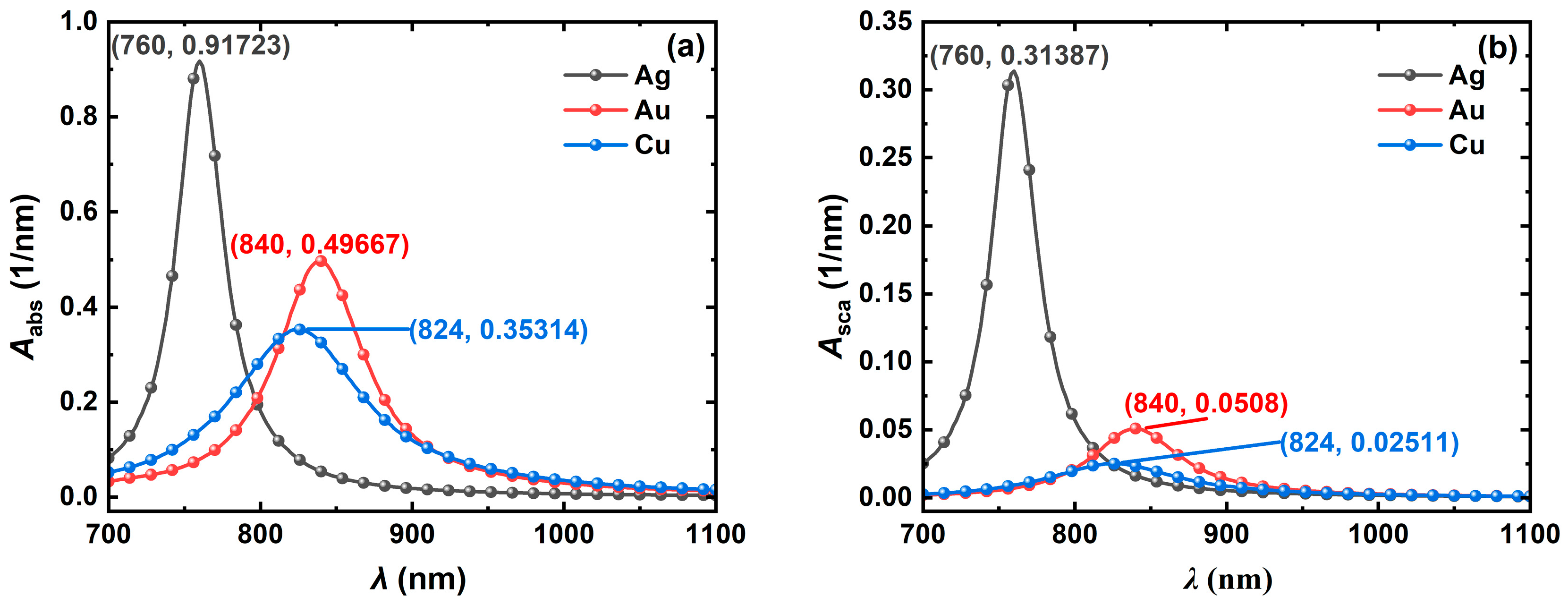
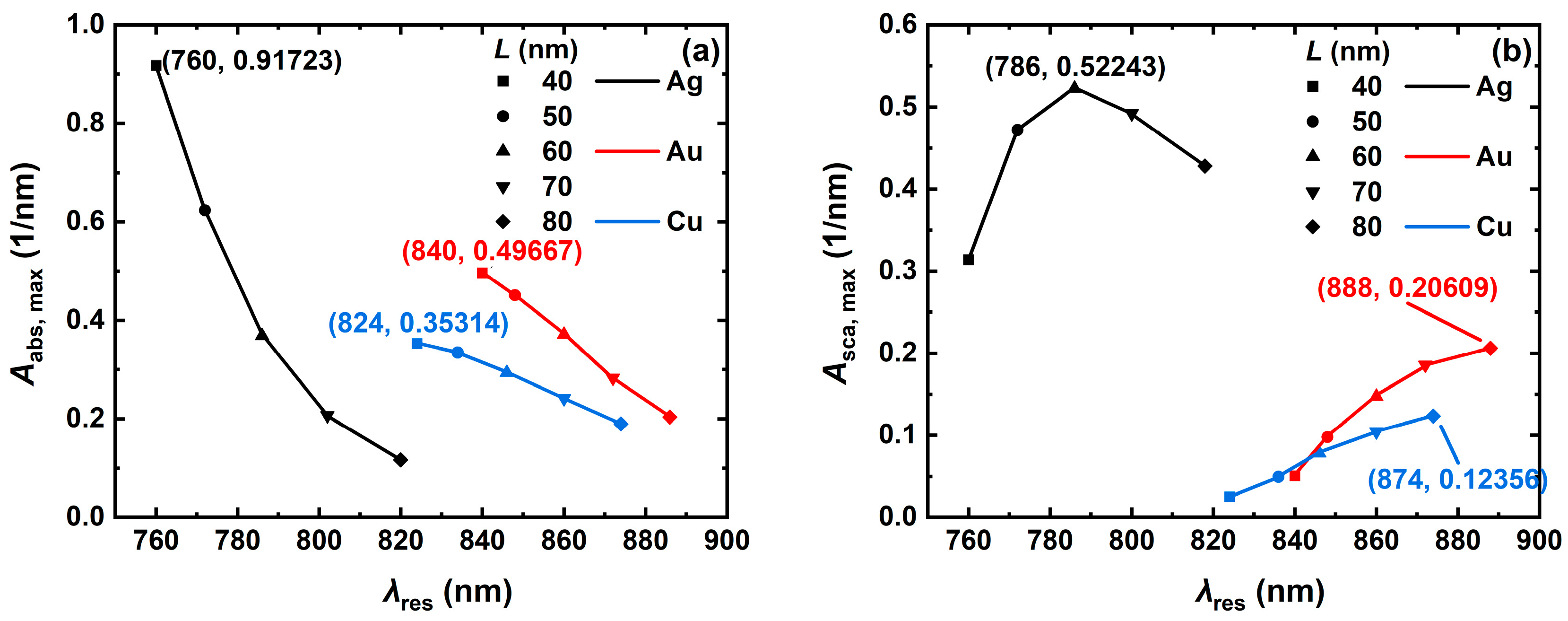
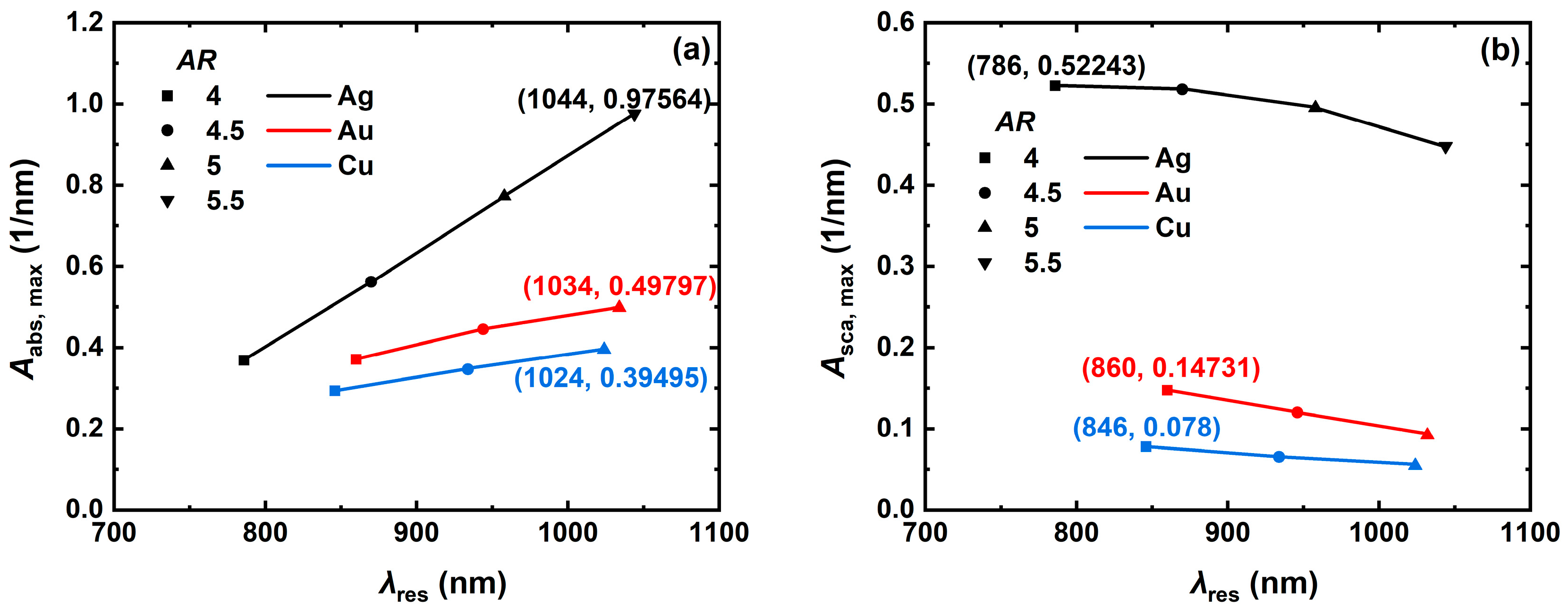
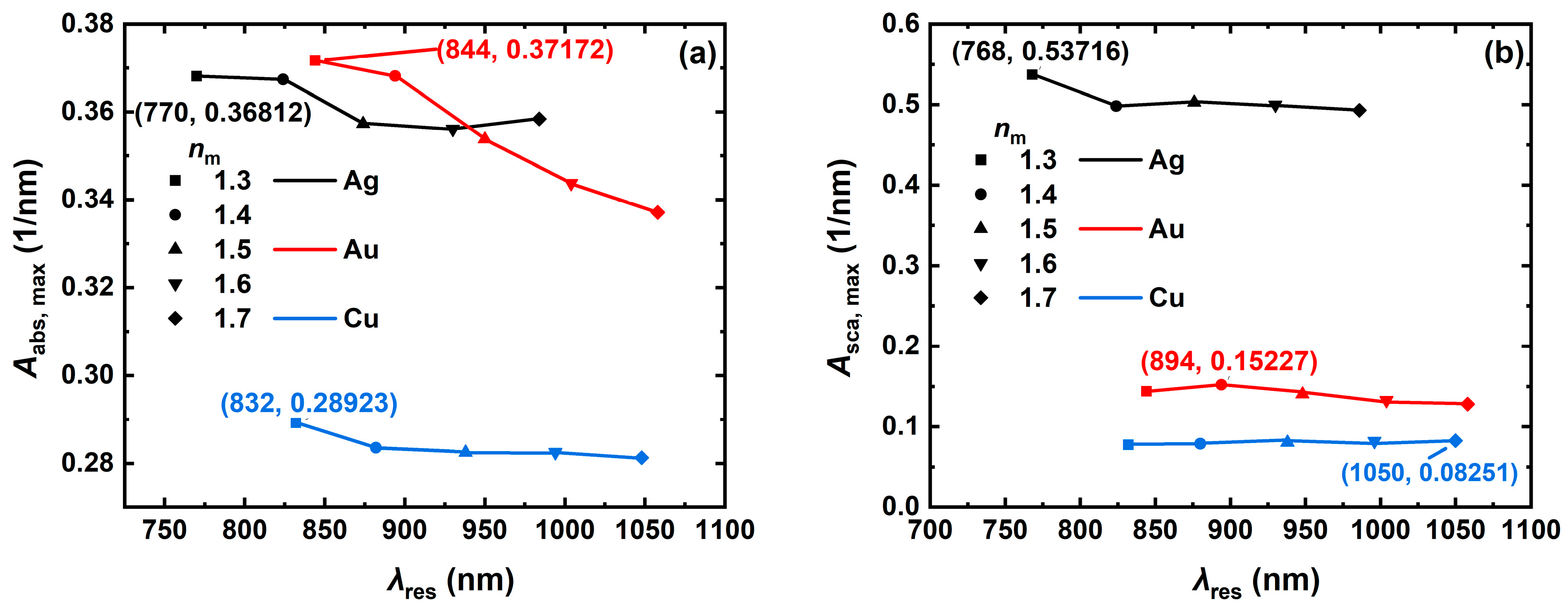

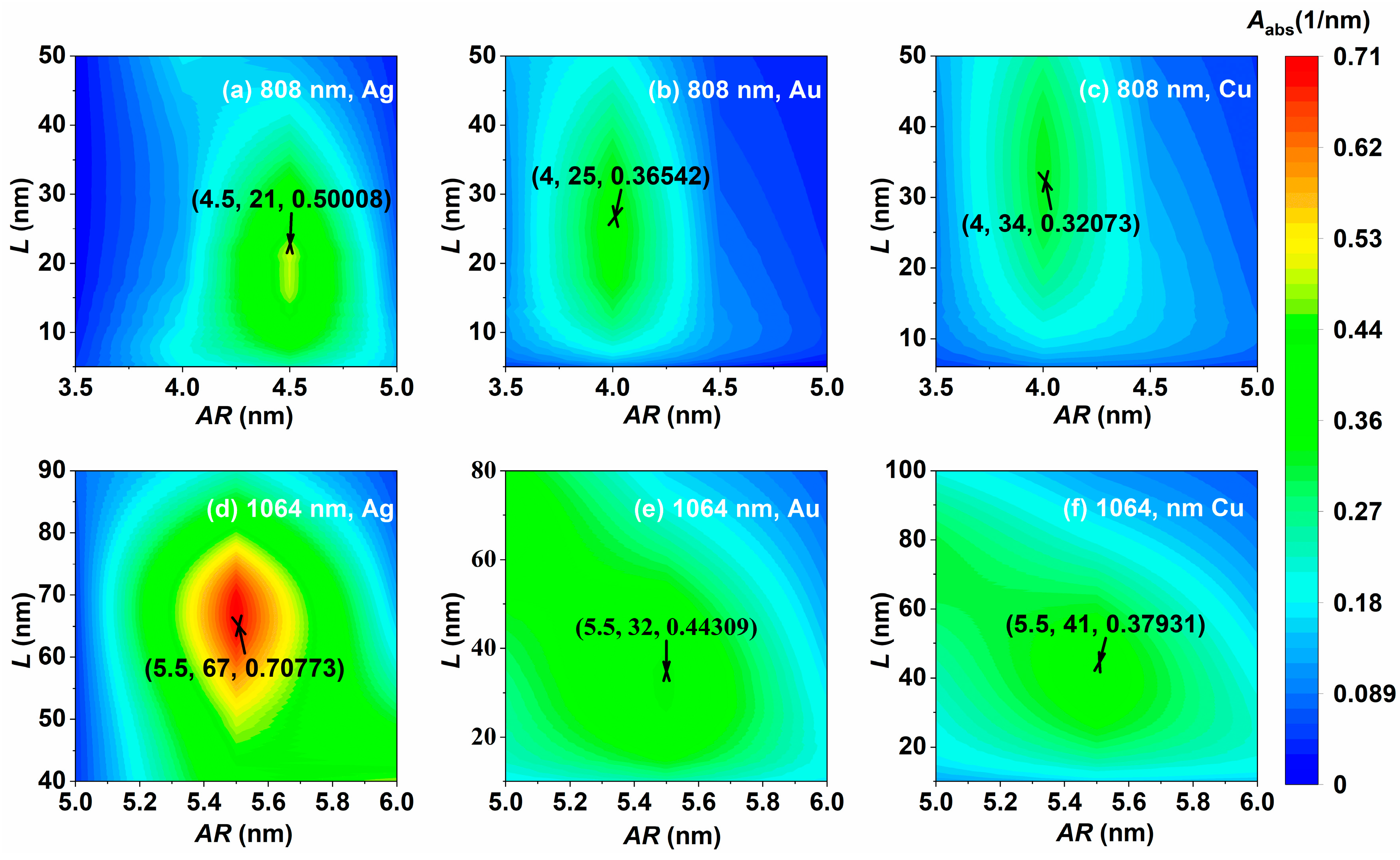
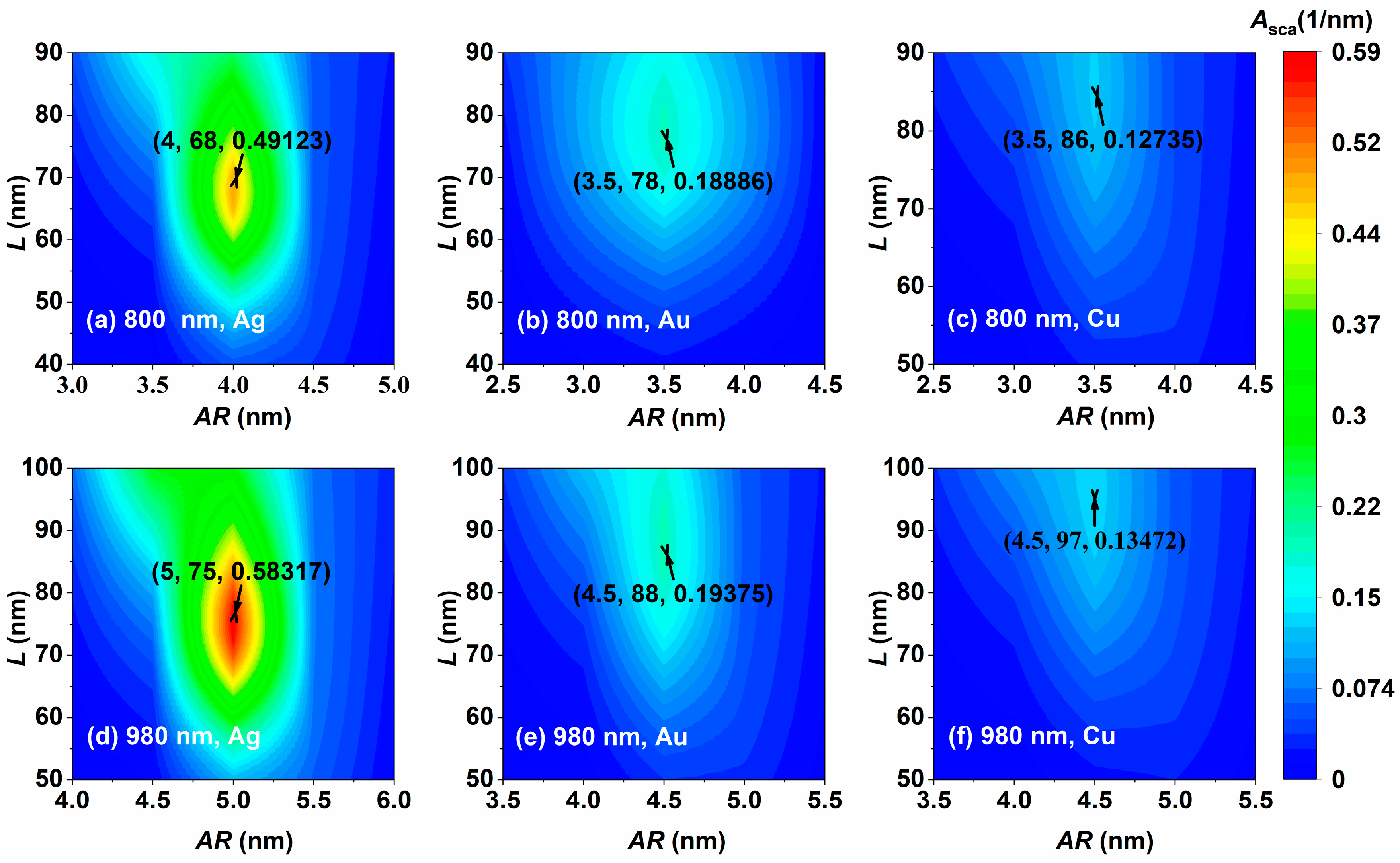
Disclaimer/Publisher’s Note: The statements, opinions and data contained in all publications are solely those of the individual author(s) and contributor(s) and not of MDPI and/or the editor(s). MDPI and/or the editor(s) disclaim responsibility for any injury to people or property resulting from any ideas, methods, instructions or products referred to in the content. |
© 2024 by the authors. Licensee MDPI, Basel, Switzerland. This article is an open access article distributed under the terms and conditions of the Creative Commons Attribution (CC BY) license (https://creativecommons.org/licenses/by/4.0/).
Share and Cite
Shao, E.; Tuersun, P.; Wumaier, D.; Li, S.; Abudula, A. Analysis and Optimization of Light Absorption and Scattering Properties of Metal Nanocages. Nanomaterials 2024, 14, 1603. https://doi.org/10.3390/nano14191603
Shao E, Tuersun P, Wumaier D, Li S, Abudula A. Analysis and Optimization of Light Absorption and Scattering Properties of Metal Nanocages. Nanomaterials. 2024; 14(19):1603. https://doi.org/10.3390/nano14191603
Chicago/Turabian StyleShao, Enhao, Paerhatijiang Tuersun, Dilishati Wumaier, Shuyuan Li, and Aibibula Abudula. 2024. "Analysis and Optimization of Light Absorption and Scattering Properties of Metal Nanocages" Nanomaterials 14, no. 19: 1603. https://doi.org/10.3390/nano14191603






